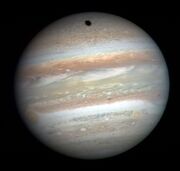
Jupiter, the largest Gas giant in the Solar System.
A gas giant is a large type of planet, which is not primarily composed of rock or any other solid matter. In the Solar System, there are four Gas giants: Jupiter, Saturn, Uranus, and Neptune. However, Uranus and Neptune are mostly composed of ice rather then liquid matter due to their distance from the Sun, so these planets are sometimes classified as an 'Ice giant'. There have been many extrasolar gas giants orbiting around other stars.
Planets above 10 Earth masses are termed 'giant planets', however lower-mass gassy planets are sometimes called "gas dwarfs".
Objects large enough to start deuterium fusion (above 13 Jupiter masses for solar composition) are called brown dwarfs, and these occupy the mass range between that of large gas giants and the lowest-mass stars.
Description
A "gas giant" is a massive planet with a thick atmosphere of hydrogen and helium and have no solid surface. However, gas giants may have a dense molten core of rocky elements, or the core may have completely dissolved and dispersed throughout the planet if the planet is hot enough. The hydrogen and helium in "traditional" gas giants like Jupiter and Saturn constitutes most of the planet, whereas the hydrogen/helium only makes up an outer envelope on Uranus and Neptune which are sometimes called ice giants, as they are mostly composed of water, ammonia, and methane molten ices.
Among extrasolar planets, Hot Jupiters are gas giants, which orbit very close to their host star, and thus have a high surface temperature. (Jupiter is cold due to it's distance from the Sun)
Hot Jupiters are currently the most common form of extrasolar planet known, perhaps due to the relative ease of detecting them.
Gas giants are commonly said to lack solid surfaces, but it is closer to the truth to say that they lack surfaces altogether since the gases that make them up simply become thinner and thinner with increasing distance from the planets' centers, eventually becoming indistinguishable from the interplanetary medium. Therefore landing on a gas giant may or may not be possible, depending on the size and composition of its core.